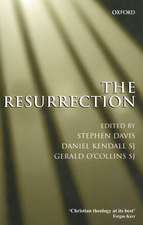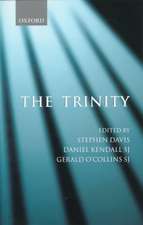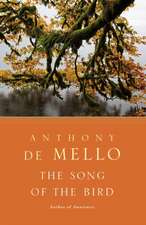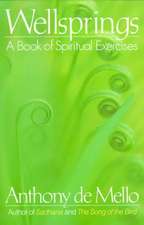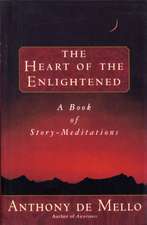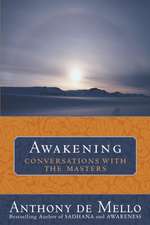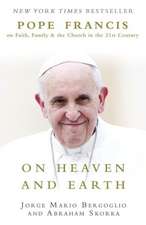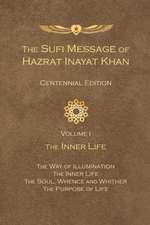Seek God Everywhere: Reflections on the Spiritual Exercises of St. Ignatius
Autor Anthony De Mello Editat de Gerald O'Collins, S. J. Kendall, Danielen Limba Engleză Paperback – 31 ian 2010
The Spiritual Exercises of St. Ignatius is one of the great masterpieces of the Christian canon. A series of meditations and practices that guides seekers on a journey to spiritual perfection, this manual has been used by millions of religious and lay persons alike for centuries.
Now, in the first new Anthony de Mello book in more than fifteen years, the bestselling author of Awareness takes readers on an in-depth exploration of the practices of St. Ignatius and offers simple guidance and wisdom to help readers navigate the sometimes-confusing byways on the journey to God. Drawn from a series of talks de Mello gave before his untimely death in 1987, this book challenges us to achieve new levels of understanding and inner exploration, with chapters on how to hear the voice of the divine, the need for repentance, and how to ascend to love in our day-to-day life,.
A must-have for fans of de Mello’s work and anyone interested in learning to pray in profound and meaningful ways, Seek God Everywhere is an inspirational and practical work that will transform your life.
Preț: 103.36 lei
Nou
Puncte Express: 155
Preț estimativ în valută:
19.78€ • 20.70$ • 16.46£
19.78€ • 20.70$ • 16.46£
Carte disponibilă
Livrare economică 10-24 martie
Preluare comenzi: 021 569.72.76
Specificații
ISBN-13: 9780385531764
ISBN-10: 0385531761
Pagini: 199
Dimensiuni: 136 x 200 x 13 mm
Greutate: 0.16 kg
Editura: IMAGE
ISBN-10: 0385531761
Pagini: 199
Dimensiuni: 136 x 200 x 13 mm
Greutate: 0.16 kg
Editura: IMAGE
Recenzii
Praise for Seek God Everywhere
“In this latest book, Father de Mello shares the treasures of St. Ignatius Loyola's classic text The Spiritual Exercises, opening up the centuries-old text in his trademark no-nonsense style. Let de Mello introduce you to the time-tested practices of Ignatian spirituality and help you find God in all things.”
ߝ James Martin, S.J., author of The Jesuit Guide to Almost Everything
“Anthony de Mello is a true spiritual master. The author of the greatest book on prayer, Sadhana, now offers the greatest book ever on the Spiritual Exercises of St. Ignatius and Jesuit spirituality. It will take you deeper into the spiritual life, deeper into God. This is the real thing, an instant spiritual classic.”
ߝ John Dear, S.J., author of Living Peace, The Questions of Jesus, and Transfiguration
“In this latest book, Father de Mello shares the treasures of St. Ignatius Loyola's classic text The Spiritual Exercises, opening up the centuries-old text in his trademark no-nonsense style. Let de Mello introduce you to the time-tested practices of Ignatian spirituality and help you find God in all things.”
ߝ James Martin, S.J., author of The Jesuit Guide to Almost Everything
“Anthony de Mello is a true spiritual master. The author of the greatest book on prayer, Sadhana, now offers the greatest book ever on the Spiritual Exercises of St. Ignatius and Jesuit spirituality. It will take you deeper into the spiritual life, deeper into God. This is the real thing, an instant spiritual classic.”
ߝ John Dear, S.J., author of Living Peace, The Questions of Jesus, and Transfiguration
Notă biografică
Anthony de Mello, S.J., was the director of the Sadhana Institute of Pastoral Counseling in Pune, India. A member of the Jesuit province of Bombay (Mumbai), he was known throughout the world for his writings and spiritual conferences. Although he died suddenly in 1987, through his many books, including Awareness, Sadhana, and The Song of the Bird, which have been translated into more than thirty- five languages, he leaves a rich legacy of spiritual teaching.
Extras
Introduction
For all those who cherish the legacy of Father Anthony de Mello, S.J. (1931ߝ1987), this book reveals and presents something that has so far been missing in his published works: the wellspring of his own spiritual life. For Tony de Mello, making the Spiritual Exercises of St. Ignatius Loyola (1491ߝ1556) for himself, directing those doing the Exercises, and teaching others to become skilled directors of the Exercises was the heart of the matter— his specifically Jesuit way to God.
In 1973 de Mello founded near Pune, India, the Sadhana (“Way to God”) Institute, a center for training spiritual guides and directors of “retreats,” a place to lead those who withdraw from their normal occupations for days or weeks of solitude and intense prayer. The third Sadhana Group consisted of seven Jesuit priests and seven religious sisters.
From July to November 1975, de Mello began the course for that group by lecturing on the Spiritual Exercises. Two or three times a week he gave hour- long talks that were taped. Several members of the group then typed out the talks and gave the others a carbon copy. Thirty years later one of the participants, Father Albert Menezes, S.J., made his copy available to us.
The pages were difficult to read: the typists had frequently used old ribbons, adopted single spacing throughout, and left very little room for margins. In any case a tropical climate had played havoc with the paper. There was no chance of scanning the text and transferring it directly to a computer. A grant from the Jesuit Foundation of the University of San Francisco enabled us to have the pages retyped entirely as a computer document.
Then we faced the task of editing the material. While preserving as much as possible the words and conversational style of de Mello, we have inserted headings and set his talks out in readable paragraphs. He did not always follow the order of the Spiritual Exercises. Hence we have, where necessary, rearranged the chapters to follow the order of the Exercises themselves. We have also added endnotes to clarify terminology: for instance, the terms Jesuits apply to their superior general in Rome (“the general”), their superiors in various parts of the world (“the provincials”), and students in training (“the scholastics”). We needed to explain as well some Indian and psychological terms. In par tic u lar, the talks of de Mello, himself a trained psychotherapist, adapted occasionally the language of transactional analysis (“parent,” “child,” and “adult”). Transactional analysis is an integrative approach to the theory of psychology and psychotherapy.
Perhaps the most time- consuming part in editing this manuscript consisted of verifying and giving precise references to different authors, both ancient and modern, when de Mello cited them. Here and there we inserted references and augmented the text with information to make his writing accessible to a wider audience. Bible quotations will reflect the New Revised Standard Version style.
For those not familiar with the Exercises, let us explain briefly what they are and how they work. The man who would become Ignatius of Loyola and the found er of the Society of Jesus (the Jesuits), was born Iñigo, the youn gest of the thirteen children of Don Beltrán Yañez de Oñez y Loyola and Marina Saenz de Lieona y Balda, in the castle of Loyola in the Basque town of Azpeitia, about forty miles southwest of Hendaye, the most southwesterly town in France. He changed his baptismal name, Iñigo, to Ignatius many years later when living in Rome.
In his early years he did not have much formal education, yet at the age of sixteen he became a page to Juan Velásquez de Cuellar, the trea sur er of the kingdom of Castile. When Velásquez died in 1517, Ignatius joined the army. In 1521, while defending the town of Pamplona against some French invaders, he was hit with a cannonball, which wounded one of his legs and broke the other. For the rest of his life he would walk with a limp.
During his convalescence he read The Golden Legend, a pop u lar collection of lives of the saints, and a Life of Christ by Ludolph the Carthusian. Reflecting quietly on the material provided by these books and on his own reactions to the reading, he experienced a profound conversion. The questions he put to himself and the spiritual experiences he underwent during his convalescence would appear years later in the pages of his Spiritual Exercises. Ignatius’s book may be, as de Mello remarks, “very dry reading” and not normal “spiritual reading,” but the Spiritual Exercises come right out of the saint’s experience. “He tells you what to do,” de Mello adds, “and how to go about doing it. When you practice it, then you will see what he is talking about. You need to experience it for yourself.”
After his conversion, Ignatius traveled to the Holy Land in 1523, then gathered a group of companions around him, and afterward studied with them for a number of years at the University of Paris, where he earned his master’s degree in 1535. Even though he wouldn’t found the Jesuits, or the Society of Jesus, until 1540, Ignatius spent nearly twenty years, between 1523 and 1541, crafting the Spiritual Exercises, directing people in them, and encouraging his followers to do the same.
The purpose of the Exercises is to find the will of God for one’s life and to receive insight and encouragement in following one’s personal call. The text itself offers guidance for those directing people making the Exercises. As de Mello observes, Ignatius’s manual “is like a cookery book. There is nothing drier than a cookery book. But if you put all the ingredients together in the proper proportions, you will produce results.” Even for those who are not directors of a retreat, the Spiritual Exercises is a wealthy collection of spiritual insight that Jesuits and laypeople have used for hundreds of years.
After proposing a prologue (the “First Principle and Foundation”), Ignatius divides the Exercises into four parts or “weeks.” These “weeks” can vary in length and do not necessarily consist of seven days. During the “first week” those making the Exercises meditate on sin and its consequences, with the aim of experiencing a deep repentance or total turning to God. During the “second week” the contemplations and meditations focus on the life of Jesus Christ. Ignatius includes during the second week (1) an “Introduction to the Consideration of Different States of Life”; (2) a “Meditation on the Two Standards” (Does the retreatant really want to serve under the standard of Christ and not that of satan?); (3) a Meditation on “Three Classes of People” (What are three different ways for finding spiritual freedom and choosing which is better?); and (4) a consideration of “Three Degrees of Humility” (How far will a person go in being entirely conformed to the will of Christ?).
The “third week” turns to contemplate Christ’s Passion and Death, and in the “fourth week” those making the Exercises contemplate his Resurrection and risen life. The final exercise is called the “Contemplation to Attain the Love of God” (the goal being to receive the grace of “finding God in all things”).
To help the directors, Ignatius adds lengthy instructions or guidelines (“Annotations,” as they were traditionally called); “Additions” or “additional directions”; and various notes and rules— above all the “Rules for the Discernment of Spirits” (see chapter 7).
The full course of Spiritual Exercises is made over a period of around thirty days and can be adapted, abbreviated, or lengthened, according to how much time people can devote to them, how fast one makes progress, and so on. Ignatius believed that the Exercises in their entirety should be made only once or twice in a person’s lifetime.
In the more than 450 years since the Spiritual Exercises came into existence, innumerable people have made them and many authors have written about them. Every Jesuit is required to make them fully at least twice: when he enters the Society and then some years later (usually between ten and twenty years) when his spiritual formation has been completed. Since individual Jesuits come from and live in almost all parts of the world, their own personal and cultural contexts affect the way they approach the Spiritual Exercises. In this book both an Indian and an international perspective come through. Let us next indicate something of the emphases, imaginative suggestions, and par tic u lar “take” on the Exercises that color the lectures de Mello gave to his Sadhana Group.
In his opening lectures (from which we continue to quote in this introduction), de Mello comments on the “Annotations,” or introductory guidelines for anyone directing or doing the Exercises. The overriding aim is to make a journey through prayer and self- awareness that provides a context for becoming spiritually free and so able to seek, find, and follow the will of God in one’s personal life. Such a pro cess of “putting order into our lives,” de Mello reflects, “really means putting order into our love.” “To love anyone or anything apart from God or as equal to God” is “inordinate; it has to be changed and purified.” “We were created for God,” de Mello insists. “Our eternal destiny is God; our hearts find rest only in God. Total satisfaction is achieved only in the infinite love of God.”
Hence de Mello can call the Exercises “a crash program for centering our hearts on God.” They enable us to let God, and no “created thing on earth,” become and remain the “center of gravity” for our lives. Characteristically, it is through a parable that de Mello illustrates this shift of gravity.
De Mello imagines an Indian girl called Mary.
She has a number of loves: she loves her parents very deeply; she loves her friends, her hobbies, and all sorts of other things. Then she falls madly in love with John, and he becomes everything to her. Does this stop her loving her parents and her friends, or does she lose interest in her work and hobbies? No, a new kind of life comes into all of this, and it is obviously charged with the intense love she now has for John. One day John’s bosses transfer him to Africa. Mary has the choice of either remaining here in India or going with him. There is no doubt in her mind; she will go to Africa. What will she feel? Will she feel sad leaving her parents? Very much so. She will feel sad for days on end; yet there is not the slightest doubt in her mind what she should do. What has happened to Mary? Her love for her parents has to some extent becomes relativized by her love for John. The new dimension in her love does not at all mean that she loses her humanity and her warmth. But somehow her other loves are transformed and given a new center of gravity.
The “spiritual love” encouraged by the Exercises does not mean, de Mello explains, “that we should give up all other loves.” Rather we should “move the center of gravity of our hearts onto Christ, and then all the rest become relative.” “Attachments,” he adds, are not evil; “they are both good and necessary. They become disordered when they become the center of our universe. No attachment to anything created may ever be the center of our loves. When we experience this centering on God, then everything else becomes relativized.”
Right from the outset de Mello highlights in his lectures the indispensable role of interior freedom in enabling our love to be centered on God and our will to choose what God truly wants from us. “People,” he says, “come to a right decision only when their hearts are free.” When we are truly free, God can attract our will to what is genuinely for our best and for his greater glory.
As much or even more than Ignatius, de Mello stresses the roles of silence and solitude as conditions for such spiritual growth. “Silence,” he assures his Sadhana Group, “is the greatest trea sure we have.” Silence can be “painful,” but it brings “purification” and allows us to confront ourselves and God. Through silence we “come in touch” with God. “In that sense, everything is found in silence.”
Like Ignatius, de Mello treats the Exercises as “essentially activity. The one thing retreatants must do is to work. Come to the retreat and work hard. In this way it is similar to a Buddhist retreat. Work, work, work, and do not sit down and listen to a retreat master.” De Mello warns against doing much reading, “because reading can serve as a pretty good defense against God. When you are wrestling with God and grappling with the state you are in, reading can be a nice anesthetic. A person takes a book and reads in the way a husband reads his newspaper during breakfast so that he will not need to talk to his wife. Reading is a nice defense. Such people are reading all about God, but are not exposing themselves to him.”
Likewise, de Mello joins Ignatius in urging fidelity to one’s program of prayer on a retreat: “Fix the time and stick to it.” He will have none of the idea of “I pray when I feel like it,” and argues on the basis of his experience: “It is precisely when people do not feel like praying that they can make great progress in prayer.” He adds:
Prayer has its ups and downs. Sometimes we feel both disgust and exhilaration. We sometimes feel both within the same hour. Although we have instant coffee and instant tea, there is no such thing as instant prayer, just as there is no such thing as instant love and instant relationship. These things need time. When people relate to God, they must invest time. There is yet another reason for staying when we feel like leaving. The inevitable experience of people who say “I pray when I feel like it” is that they pray less and less. Then they need to start all over again.
Along with this sober advice, de Mello also promises that those who make the Exercises with faithful generosity can be led to mystical experience. An intense, immediate, and deeply consoling communion with God in prayer frequently results from such fidelity.
When in 1975 de Mello gave the talks that make up this book, he used the translation by Louis J. Puhl, S.J., The Spiritual Exercises of St. Ignatius (Chicago: Loyola University Press, 1951). Since de Mello delivered his talks in 1975 and, in par tic u lar, since his untimely death in 1987, other translations have appeared: for instance, Joseph A. Munitiz and Philip Endean, Saint Ignatius of Loyola: Personal Writings (London: Penguin, 1996); and David L. Fleming, Draw Me into Your Friendship. A Literal Translation and Contemporary Reading of the Spiritual Exercises (St. Louis: Institute of Jesuit Sources, 1996). Many excellent studies of the Exercises have also been published: for example, James L. Connor et al., The Dynamism of Desire: Bernard J. F. Lonergan, S.J., on the Spiritual Exercises of Saint Ignatius of Loyola (St. Louis: Institute of Jesuit Sources, 2006); David L. Fleming, ed., Notes on the Spiritual Exercises of St. Ignatius of Loyola (St. Louis: Review for Religious, 1981); and Michael Ivens, Understanding the Spiritual Exercises (Leominster, Herefordshire: Gracewing, 1998). To update what de Mello said in his talks, we have at some points introduced endnotes from these and other authors.
We are most grateful to Father Albert Menezes for providing us with his copy of the notes from 1975 and to Francis de Melo, Jesuit Provincial of Bombay, for allowing us to use them. We want to express our deep gratitude to Philip Endean for help in tracing sources used by de Mello and to Father David Fleming, longtime editor of Review for Religious, for making very valuable suggestions about editing these talks by de Mello. We are indebted to our literary agent, Mr. Joseph Durepos, and to Gary Jansen of Double-day for their hard work and expert advice in helping us prepare this manuscript. We have deposited in the Archives of the California Province of the Society of Jesus (1) the original text entrusted to us by Father Albert Menezes, (2) the complete typescript we had made from this text, and (3) our edited version in its first, longer state.
We dedicate this book to the memory of Anthony de Mello, a trea sured and delightful companion in the Society of Jesus. An inspiring teacher, for his lectures in 1975 he drew on a wide range of written sources, both primary and secondary, as well as on his own personal experience as a master of the spiritual life. May this book illustrate something very dear to him: the enduring power of the Spiritual Exercises to bring believers everywhere closer to God and to their fellow human beings.
For all those who cherish the legacy of Father Anthony de Mello, S.J. (1931ߝ1987), this book reveals and presents something that has so far been missing in his published works: the wellspring of his own spiritual life. For Tony de Mello, making the Spiritual Exercises of St. Ignatius Loyola (1491ߝ1556) for himself, directing those doing the Exercises, and teaching others to become skilled directors of the Exercises was the heart of the matter— his specifically Jesuit way to God.
In 1973 de Mello founded near Pune, India, the Sadhana (“Way to God”) Institute, a center for training spiritual guides and directors of “retreats,” a place to lead those who withdraw from their normal occupations for days or weeks of solitude and intense prayer. The third Sadhana Group consisted of seven Jesuit priests and seven religious sisters.
From July to November 1975, de Mello began the course for that group by lecturing on the Spiritual Exercises. Two or three times a week he gave hour- long talks that were taped. Several members of the group then typed out the talks and gave the others a carbon copy. Thirty years later one of the participants, Father Albert Menezes, S.J., made his copy available to us.
The pages were difficult to read: the typists had frequently used old ribbons, adopted single spacing throughout, and left very little room for margins. In any case a tropical climate had played havoc with the paper. There was no chance of scanning the text and transferring it directly to a computer. A grant from the Jesuit Foundation of the University of San Francisco enabled us to have the pages retyped entirely as a computer document.
Then we faced the task of editing the material. While preserving as much as possible the words and conversational style of de Mello, we have inserted headings and set his talks out in readable paragraphs. He did not always follow the order of the Spiritual Exercises. Hence we have, where necessary, rearranged the chapters to follow the order of the Exercises themselves. We have also added endnotes to clarify terminology: for instance, the terms Jesuits apply to their superior general in Rome (“the general”), their superiors in various parts of the world (“the provincials”), and students in training (“the scholastics”). We needed to explain as well some Indian and psychological terms. In par tic u lar, the talks of de Mello, himself a trained psychotherapist, adapted occasionally the language of transactional analysis (“parent,” “child,” and “adult”). Transactional analysis is an integrative approach to the theory of psychology and psychotherapy.
Perhaps the most time- consuming part in editing this manuscript consisted of verifying and giving precise references to different authors, both ancient and modern, when de Mello cited them. Here and there we inserted references and augmented the text with information to make his writing accessible to a wider audience. Bible quotations will reflect the New Revised Standard Version style.
For those not familiar with the Exercises, let us explain briefly what they are and how they work. The man who would become Ignatius of Loyola and the found er of the Society of Jesus (the Jesuits), was born Iñigo, the youn gest of the thirteen children of Don Beltrán Yañez de Oñez y Loyola and Marina Saenz de Lieona y Balda, in the castle of Loyola in the Basque town of Azpeitia, about forty miles southwest of Hendaye, the most southwesterly town in France. He changed his baptismal name, Iñigo, to Ignatius many years later when living in Rome.
In his early years he did not have much formal education, yet at the age of sixteen he became a page to Juan Velásquez de Cuellar, the trea sur er of the kingdom of Castile. When Velásquez died in 1517, Ignatius joined the army. In 1521, while defending the town of Pamplona against some French invaders, he was hit with a cannonball, which wounded one of his legs and broke the other. For the rest of his life he would walk with a limp.
During his convalescence he read The Golden Legend, a pop u lar collection of lives of the saints, and a Life of Christ by Ludolph the Carthusian. Reflecting quietly on the material provided by these books and on his own reactions to the reading, he experienced a profound conversion. The questions he put to himself and the spiritual experiences he underwent during his convalescence would appear years later in the pages of his Spiritual Exercises. Ignatius’s book may be, as de Mello remarks, “very dry reading” and not normal “spiritual reading,” but the Spiritual Exercises come right out of the saint’s experience. “He tells you what to do,” de Mello adds, “and how to go about doing it. When you practice it, then you will see what he is talking about. You need to experience it for yourself.”
After his conversion, Ignatius traveled to the Holy Land in 1523, then gathered a group of companions around him, and afterward studied with them for a number of years at the University of Paris, where he earned his master’s degree in 1535. Even though he wouldn’t found the Jesuits, or the Society of Jesus, until 1540, Ignatius spent nearly twenty years, between 1523 and 1541, crafting the Spiritual Exercises, directing people in them, and encouraging his followers to do the same.
The purpose of the Exercises is to find the will of God for one’s life and to receive insight and encouragement in following one’s personal call. The text itself offers guidance for those directing people making the Exercises. As de Mello observes, Ignatius’s manual “is like a cookery book. There is nothing drier than a cookery book. But if you put all the ingredients together in the proper proportions, you will produce results.” Even for those who are not directors of a retreat, the Spiritual Exercises is a wealthy collection of spiritual insight that Jesuits and laypeople have used for hundreds of years.
After proposing a prologue (the “First Principle and Foundation”), Ignatius divides the Exercises into four parts or “weeks.” These “weeks” can vary in length and do not necessarily consist of seven days. During the “first week” those making the Exercises meditate on sin and its consequences, with the aim of experiencing a deep repentance or total turning to God. During the “second week” the contemplations and meditations focus on the life of Jesus Christ. Ignatius includes during the second week (1) an “Introduction to the Consideration of Different States of Life”; (2) a “Meditation on the Two Standards” (Does the retreatant really want to serve under the standard of Christ and not that of satan?); (3) a Meditation on “Three Classes of People” (What are three different ways for finding spiritual freedom and choosing which is better?); and (4) a consideration of “Three Degrees of Humility” (How far will a person go in being entirely conformed to the will of Christ?).
The “third week” turns to contemplate Christ’s Passion and Death, and in the “fourth week” those making the Exercises contemplate his Resurrection and risen life. The final exercise is called the “Contemplation to Attain the Love of God” (the goal being to receive the grace of “finding God in all things”).
To help the directors, Ignatius adds lengthy instructions or guidelines (“Annotations,” as they were traditionally called); “Additions” or “additional directions”; and various notes and rules— above all the “Rules for the Discernment of Spirits” (see chapter 7).
The full course of Spiritual Exercises is made over a period of around thirty days and can be adapted, abbreviated, or lengthened, according to how much time people can devote to them, how fast one makes progress, and so on. Ignatius believed that the Exercises in their entirety should be made only once or twice in a person’s lifetime.
In the more than 450 years since the Spiritual Exercises came into existence, innumerable people have made them and many authors have written about them. Every Jesuit is required to make them fully at least twice: when he enters the Society and then some years later (usually between ten and twenty years) when his spiritual formation has been completed. Since individual Jesuits come from and live in almost all parts of the world, their own personal and cultural contexts affect the way they approach the Spiritual Exercises. In this book both an Indian and an international perspective come through. Let us next indicate something of the emphases, imaginative suggestions, and par tic u lar “take” on the Exercises that color the lectures de Mello gave to his Sadhana Group.
In his opening lectures (from which we continue to quote in this introduction), de Mello comments on the “Annotations,” or introductory guidelines for anyone directing or doing the Exercises. The overriding aim is to make a journey through prayer and self- awareness that provides a context for becoming spiritually free and so able to seek, find, and follow the will of God in one’s personal life. Such a pro cess of “putting order into our lives,” de Mello reflects, “really means putting order into our love.” “To love anyone or anything apart from God or as equal to God” is “inordinate; it has to be changed and purified.” “We were created for God,” de Mello insists. “Our eternal destiny is God; our hearts find rest only in God. Total satisfaction is achieved only in the infinite love of God.”
Hence de Mello can call the Exercises “a crash program for centering our hearts on God.” They enable us to let God, and no “created thing on earth,” become and remain the “center of gravity” for our lives. Characteristically, it is through a parable that de Mello illustrates this shift of gravity.
De Mello imagines an Indian girl called Mary.
She has a number of loves: she loves her parents very deeply; she loves her friends, her hobbies, and all sorts of other things. Then she falls madly in love with John, and he becomes everything to her. Does this stop her loving her parents and her friends, or does she lose interest in her work and hobbies? No, a new kind of life comes into all of this, and it is obviously charged with the intense love she now has for John. One day John’s bosses transfer him to Africa. Mary has the choice of either remaining here in India or going with him. There is no doubt in her mind; she will go to Africa. What will she feel? Will she feel sad leaving her parents? Very much so. She will feel sad for days on end; yet there is not the slightest doubt in her mind what she should do. What has happened to Mary? Her love for her parents has to some extent becomes relativized by her love for John. The new dimension in her love does not at all mean that she loses her humanity and her warmth. But somehow her other loves are transformed and given a new center of gravity.
The “spiritual love” encouraged by the Exercises does not mean, de Mello explains, “that we should give up all other loves.” Rather we should “move the center of gravity of our hearts onto Christ, and then all the rest become relative.” “Attachments,” he adds, are not evil; “they are both good and necessary. They become disordered when they become the center of our universe. No attachment to anything created may ever be the center of our loves. When we experience this centering on God, then everything else becomes relativized.”
Right from the outset de Mello highlights in his lectures the indispensable role of interior freedom in enabling our love to be centered on God and our will to choose what God truly wants from us. “People,” he says, “come to a right decision only when their hearts are free.” When we are truly free, God can attract our will to what is genuinely for our best and for his greater glory.
As much or even more than Ignatius, de Mello stresses the roles of silence and solitude as conditions for such spiritual growth. “Silence,” he assures his Sadhana Group, “is the greatest trea sure we have.” Silence can be “painful,” but it brings “purification” and allows us to confront ourselves and God. Through silence we “come in touch” with God. “In that sense, everything is found in silence.”
Like Ignatius, de Mello treats the Exercises as “essentially activity. The one thing retreatants must do is to work. Come to the retreat and work hard. In this way it is similar to a Buddhist retreat. Work, work, work, and do not sit down and listen to a retreat master.” De Mello warns against doing much reading, “because reading can serve as a pretty good defense against God. When you are wrestling with God and grappling with the state you are in, reading can be a nice anesthetic. A person takes a book and reads in the way a husband reads his newspaper during breakfast so that he will not need to talk to his wife. Reading is a nice defense. Such people are reading all about God, but are not exposing themselves to him.”
Likewise, de Mello joins Ignatius in urging fidelity to one’s program of prayer on a retreat: “Fix the time and stick to it.” He will have none of the idea of “I pray when I feel like it,” and argues on the basis of his experience: “It is precisely when people do not feel like praying that they can make great progress in prayer.” He adds:
Prayer has its ups and downs. Sometimes we feel both disgust and exhilaration. We sometimes feel both within the same hour. Although we have instant coffee and instant tea, there is no such thing as instant prayer, just as there is no such thing as instant love and instant relationship. These things need time. When people relate to God, they must invest time. There is yet another reason for staying when we feel like leaving. The inevitable experience of people who say “I pray when I feel like it” is that they pray less and less. Then they need to start all over again.
Along with this sober advice, de Mello also promises that those who make the Exercises with faithful generosity can be led to mystical experience. An intense, immediate, and deeply consoling communion with God in prayer frequently results from such fidelity.
When in 1975 de Mello gave the talks that make up this book, he used the translation by Louis J. Puhl, S.J., The Spiritual Exercises of St. Ignatius (Chicago: Loyola University Press, 1951). Since de Mello delivered his talks in 1975 and, in par tic u lar, since his untimely death in 1987, other translations have appeared: for instance, Joseph A. Munitiz and Philip Endean, Saint Ignatius of Loyola: Personal Writings (London: Penguin, 1996); and David L. Fleming, Draw Me into Your Friendship. A Literal Translation and Contemporary Reading of the Spiritual Exercises (St. Louis: Institute of Jesuit Sources, 1996). Many excellent studies of the Exercises have also been published: for example, James L. Connor et al., The Dynamism of Desire: Bernard J. F. Lonergan, S.J., on the Spiritual Exercises of Saint Ignatius of Loyola (St. Louis: Institute of Jesuit Sources, 2006); David L. Fleming, ed., Notes on the Spiritual Exercises of St. Ignatius of Loyola (St. Louis: Review for Religious, 1981); and Michael Ivens, Understanding the Spiritual Exercises (Leominster, Herefordshire: Gracewing, 1998). To update what de Mello said in his talks, we have at some points introduced endnotes from these and other authors.
We are most grateful to Father Albert Menezes for providing us with his copy of the notes from 1975 and to Francis de Melo, Jesuit Provincial of Bombay, for allowing us to use them. We want to express our deep gratitude to Philip Endean for help in tracing sources used by de Mello and to Father David Fleming, longtime editor of Review for Religious, for making very valuable suggestions about editing these talks by de Mello. We are indebted to our literary agent, Mr. Joseph Durepos, and to Gary Jansen of Double-day for their hard work and expert advice in helping us prepare this manuscript. We have deposited in the Archives of the California Province of the Society of Jesus (1) the original text entrusted to us by Father Albert Menezes, (2) the complete typescript we had made from this text, and (3) our edited version in its first, longer state.
We dedicate this book to the memory of Anthony de Mello, a trea sured and delightful companion in the Society of Jesus. An inspiring teacher, for his lectures in 1975 he drew on a wide range of written sources, both primary and secondary, as well as on his own personal experience as a master of the spiritual life. May this book illustrate something very dear to him: the enduring power of the Spiritual Exercises to bring believers everywhere closer to God and to their fellow human beings.
Descriere
In this inspiring work, the author of "Awareness" provides his unique insightinto the "Spiritual Exercises of St. Ignatius," one of the great masterpiecesof Christian spirituality.


